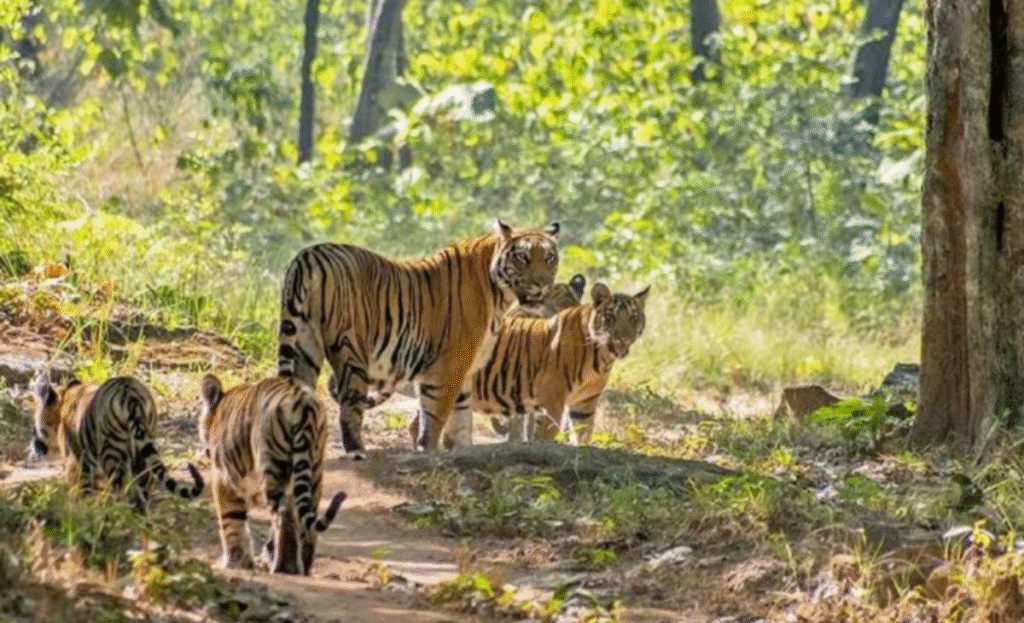The name Satpura instantly evokes the imagery of Bhawani Prasad Mishra’s famous poem, ‘Satpura Ke Ghane Jungle’, which beautifully captures the essence of these forests in a rhythmic and vivid manner.
Like many nature lovers, this poem holds a special place in my heart. Today, let’s delve into the mysteries and wonders of the Satpura forests.
Natural treasure of central India
Satpura, meaning Seven Mountains, is a range of hills and valleys spread across Madhya Pradesh and Maharashtra. Its breath-taking natural beauty, rich biodiversity and dense vegetation make it an invaluable treasure of central India.

The forests are home to a variety of wildlife, including tigers, leopards, sloth bears, sambars, gaurs, chitals, porcupines and several species of deer. The avian population includes hornbills, flycatchers, eagles, hawks, ducks, geese and kingfishers, making it a paradise for bird watchers.
The flora of Satpura is equally diverse, with towering teak and sal trees, particularly abundant in the Pachmarhi plateau. Other significant trees include mahua, whose flowers and fruits serve multiple purposes for locals, bael, known for its medicinal properties, and tendu, whose leaves are used for making bidis.
The forests also harbor a variety of shrubs, grasses, and vines, many of which possess medicinal properties and are rich in rare herbs.
Role of forests in local livelihoods
The forests of Satpura provide sustenance to local and tribal communities. The Gond, Bhil, Korku and Baiga tribes inhabit these forests, each with distinct languages, customs and traditions.
Their livelihoods revolve around agriculture, forest produce collection (such as herbs, gum, honey and tendu leaves), hunting, fishing, animal husbandry and labour work. Their deep understanding of nature and vegetation makes them adept at utilising forest resources sustainably.

The tribal communities are also renowned for their art and craftsmanship, producing exquisite clay pottery, bamboo artefacts and traditional jewellery. Their music and dance are mesmerising, reflecting their rich cultural heritage. However, challenges such as education, healthcare, poverty and unemployment remain significant concerns.
Hidden mysteries of Satpura
Satpura’s dense forests conceal numerous mysterious caves with historical, mythological, and geological significance. Some of the most fascinating caves include:
• Bhimbetka Caves – Located on the northern edge of Satpura, these caves are an important archaeological site. The rock paintings, depicting hunting, dancing, animals and daily life, date back 30,000 years, offering a glimpse into early human civilisation. Bhimbetka is recognised as a UNESCO World Heritage Site.

• Pachmarhi Caves – Known as the Queen of Satpura, Pachmarhi features caves carved into five rock formations, believed to be the refuge of the Pandavas during their exile. However, archaeological studies suggest that these caves were Buddhist monasteries from the 1st century and even date back to the Mauryan era under Emperor Ashoka.
• Jatashankar and Gupt Mahadev Caves – These caves hold special significance for Shiva devotees, nestled in narrow and secluded locations. Their serene and sacred atmosphere makes them revered pilgrimage sites.
Apart from these, several unexplored caves remain hidden due to the rugged terrain, adding to the mystique of Satpura.
Preserving Satpura’s Legacy
Satpura’s forests are a treasure trove of biodiversity, cultural heritage, and natural beauty. However, deforestation and unregulated exploitation pose serious threats to its wildlife and ecological balance. It is crucial to protect and conserve these forests to ensure their survival for future generations.

To protect the forests of Satpura, it is essential that trees are only cut for development projects with proper authorisation. Otherwise, strict and effective laws must be enacted. It is necessary to plant new trees in place of the ones that are cut, and measures should be taken to prevent soil erosion, with support from both government and non-government organisations.
Forest fires pose a significant threat here, causing severe damage to wildlife species. Awareness campaigns should be conducted to prevent illegal hunting of animals.
For the preservation of the caves in this region, human interference should be limited to avoid serious harm to their structure and ecological balance. Proper instructions should be displayed for cleanliness and designated pathways for tourists, ensuring the conservation of Satpura’s forests.
Satpura’s dense and mysterious jungles continue to captivate adventurers, historians, and nature lovers alike. Their untamed beauty, rich wildlife, and hidden secrets make them one of India’s most fascinating landscapes.
Himani Sharma





